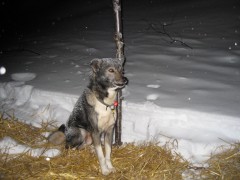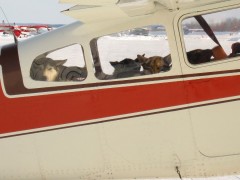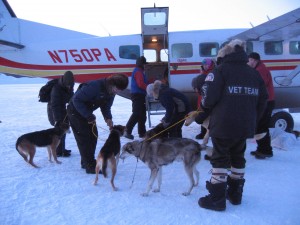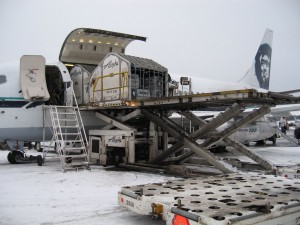
Mushers can leave the starting chute at Willow with as many as sixteen dogs and they must finish with no fewer than 6 dogs in harness. It’s true that some mushers finish with 16 but most drop dogs at check points along the trail. What happens to the dropped dogs? How do they get home to their kennel and back to their own houses and bowls? Remember, handlers can’t just drive the dog truck out to a checkpoint to pick up a dropped dog because NONE of the Iditarod checkpoints are on the Alaskan road system! The same is true for Nome where the race finishes – no roads lead to Nome so there are no roads home.
Dogs that are dropped at checkpoints are left in the capable hands of the veterinarians and a dog handler in charge of dropped dogs. Mushers are required to leave food for their dog. Anchorage logistics is notified of the number of dogs left behind at the checkpoints. Logistics dispatches an Iditarod Air Force plane and pilot to the checkpoints to pick the dogs up.

Where the Iditarod Air Force flies the dropped dogs to depends upon where the dogs are dropped. Dogs left at Yentna, Skwentna, Finger Lake or Rainy Pass are given window seats in the small Cessnas and then fly directly back to Anchorage where they are delivered to The Millennium Hotel, race headquarters, where they wait for their handlers to arrive.
Once a team has gone up and over the Alaska Range and reached Rohn, dropped dogs are flown in a small Iditarod Air Force plane to the closest transportation hub – McGrath, Unalakleet or Nome before flying back to Anchorage.
 Here’s how the chain of events unfolded at McGrath. Dropped dogs are transported from the checkpoint to the dropped dog line at the airstrip. Pretty soon the Pen Air Caravan, a cargo plane, arrives. The dogs have to produce their own boarding pass signed by a vet in order to board the plane but they don’t have to show a photo ID or go through a metal detector like humans do. As they are lifted into the plane, their necklines are clipped to rings along the side of the fuselage. On the flight that handler took from McGrath back to Anchorage, there were 2 pilots, 30 canine passengers and 5 human passengers including Linwood Fiedler who scratched in McGrath. Sled dogs are great passengers. During the 1-½ hour flight, they snuggled up to their neighbor and slept. During the entire flight, there were only 2 woofs from the dogs but lots of snoring from the humans. Once the Caravan was on the ground in Anchorage, Fiedler’s dogs were unloaded from the plane then reloaded into his dog truck. The remaining dogs were loaded into Iditarod’s dog truck and transported to the finest hotel in all of Anchorage where race headquarters is located to wait for their handlers. All in all in 2010, there were 21 dogs dropped in McGrath plus Karen Ramstead scratched with 14 dogs, Linwood Fiedler with 11 dogs and Justin Savidis with 15 dogs. That’s a lot of doggie window seats and frequent flyer miles!
Here’s how the chain of events unfolded at McGrath. Dropped dogs are transported from the checkpoint to the dropped dog line at the airstrip. Pretty soon the Pen Air Caravan, a cargo plane, arrives. The dogs have to produce their own boarding pass signed by a vet in order to board the plane but they don’t have to show a photo ID or go through a metal detector like humans do. As they are lifted into the plane, their necklines are clipped to rings along the side of the fuselage. On the flight that handler took from McGrath back to Anchorage, there were 2 pilots, 30 canine passengers and 5 human passengers including Linwood Fiedler who scratched in McGrath. Sled dogs are great passengers. During the 1-½ hour flight, they snuggled up to their neighbor and slept. During the entire flight, there were only 2 woofs from the dogs but lots of snoring from the humans. Once the Caravan was on the ground in Anchorage, Fiedler’s dogs were unloaded from the plane then reloaded into his dog truck. The remaining dogs were loaded into Iditarod’s dog truck and transported to the finest hotel in all of Anchorage where race headquarters is located to wait for their handlers. All in all in 2010, there were 21 dogs dropped in McGrath plus Karen Ramstead scratched with 14 dogs, Linwood Fiedler with 11 dogs and Justin Savidis with 15 dogs. That’s a lot of doggie window seats and frequent flyer miles!
 Don’t forget about Nome. When the mushers and dog teams are announced by the fire siren and cross under the burled arch, they all need to get home from Nome. The Bering Sea is frozen so boats aren’t an option. There are no railroads leading to or from Nome, like wise there are no roads. The dogs depart Nome via Alaska Airlines as 1st class passengers. Yes, that’s right, you can see by the picture in the photo story that the dog crates are being loaded onto the plane where rows 1 thru 10 would normally be. Yes, the seats have been removed so the dogs can be more comfortable in their personal kennels. These K-9 athletes deserve only the best. They have just covered a distance equal to 40 back-to-back marathons. By the way, in 2010, Wattie McDonald was the only musher to finish with all 16 dogs. Amazing!
Don’t forget about Nome. When the mushers and dog teams are announced by the fire siren and cross under the burled arch, they all need to get home from Nome. The Bering Sea is frozen so boats aren’t an option. There are no railroads leading to or from Nome, like wise there are no roads. The dogs depart Nome via Alaska Airlines as 1st class passengers. Yes, that’s right, you can see by the picture in the photo story that the dog crates are being loaded onto the plane where rows 1 thru 10 would normally be. Yes, the seats have been removed so the dogs can be more comfortable in their personal kennels. These K-9 athletes deserve only the best. They have just covered a distance equal to 40 back-to-back marathons. By the way, in 2010, Wattie McDonald was the only musher to finish with all 16 dogs. Amazing!
Born to Run,
Sanka


